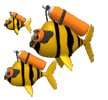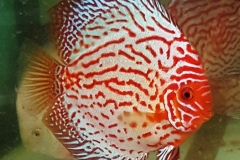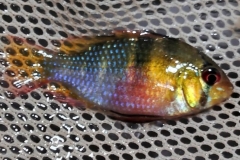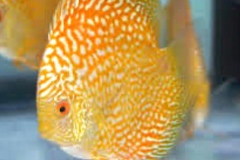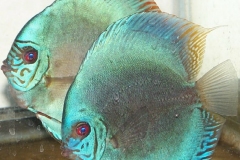Artificially raising Angelfish is actually very easy and if you are looking to have the highest survival ratio it is definitely the way to go.
We raise the fry in 5 gallon tanks. Getting the water correct is very important. You should take water out of the spawning tank right before transferring the eggs and put it in the 5 gallon tank. The temperature of the tank they are coming from and the one it is going into has to be the same. A difference of even a couple of degrees will kill the eggs. Clean water is absolutely essential for hatching the fry as if the water is at all dirty, fungus will form on the eggs. That is one reason that keeping the spawning tank water extremely clean is so important. To assist in keeping fungus from forming, we do two additional things. We add Methylene Blue to the water. Add enough to turn the water a deep blue. We also run heavy aeration next to the eggs, creating a current, which helps to stop fungus from forming. When the tank is ready and all the above conditions are met, quickly take the eggs out of the spawning tank and place them into the rearing tank. They should not be out of the water more than 10 seconds. Just a heads up, the spawning Angelfish will be very unhappy about you taking their eggs out. They will attack your hand and while it really does not hurt, it can be quite startling. To reduce that, I usually tap on the opposite end of the tank to distract them then quickly reach in with my other hand to take the eggs out. Hopefully the eggs will be on a breeding cone or something else that is very easy to remove. If the tank they are coming from is a ways away from the tank they are going into, I use a 2 gallon bucket full of water from the spawning tank to move the eggs into before I move them to the rearing tank.
Once the fry become Free Swimming at around 6 days, you will need to feed them within 24 hours. You should set up a Brine Shrimp hatchery on the fifth day so you can feed them newly hatched brine shrimp within hours of them becoming free swimming. They will not eat much at first and you do not want to foul the water adding two much. As the size of the spawn will vary significantly, how much you feed them will be somethings you have to decide when they hatch out. Feed your new Angelfish baby Brine Shrimp for three weeks. After three weeks start cutting back on the baby brine shrimp and when you feed them add in some finely ground flake food. Between 3 weeks and 5 weeks, slowly decrease the Brine Shrimp and increase the flake food until after the fifth week, they are eating only flake food.
After 5 weeks, you will need to transfer them to a larger tank. When Angelfish are crowded in a tank, their growth gets stunted. They will grow VERY slowly to not at all if left in a small 5 gallon tank. The size of the tank they need to be moved into depends on the size of the spawn. Spawn size can be from just a few to a couple of thousand. I once had a spawn of 2400 from one silver pair. Black and Silver Angelfish usually have the largest spawns. Young pairs typically have relatively small spawns, but the size of the spawn will increase as they mature.
In our next issue, we will go over naturally raising the fry.
